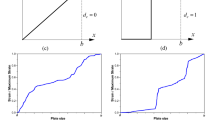Abstract
A new multi-scale numerical model is presented using the fractal theory and adopting FEM to simulate the failure of concrete. The relation between the fractal box dimension in large scale and the damage to concrete in small scale is deduced. And the evolutionary process of elastic modulus and strength in small scale is given. Consequently, the multi-scale numerical model is proposed to describe the constitutive relation of concrete between small scale and large scale. A two-dimensional static analysis of a concrete block is performed by using this model and the calculation result is discussed. The propagation of cracks of the concrete block is also studied.
Similar content being viewed by others
References
Wittmann, F.H., Structure of Concrete with Respect to Crack Formation. Netherlands: Elsevier Science Publishers, 1989: 43–74.
Li, Y.C., Ma, H.F. and Chen, X., Analysis of concrete 3-D meso-mechanical model. Journal of Shandong Institute of Commerce and Technolog, 2007, 7(3): 98–101.
Li, Y.C, Ma, H.F., Chen, H.Q. and Xu, X., Approach to generation of random convex polyhedral aggregate model and plotting for concrete meso-mechanics. Journal of Hydraulic Engineering, 2006, 5: 588–592.
Alberto, C., Bernardino, C. and Pietro, C., On the mechanics of quasi-brittle materials with a fractal microstructure. Engineering Fracture Mechanics, 2003, 70: 2321–2349.
Gianluca, C., Zdenek, P., Bazant, F. and Luigi, C., Confinement-shear lattice model for concrete damage in tension and compression: I. Theory. Journal of Engineering Mechanics, 2003, 129(12): 1439–1448.
Zdenek, P., Ferhun, C., Ignacio, C., Mark, D. and Stephen, A., Microplane model m4 for concrete: I. formulation with work-conjugate deviatoric stress. Journal of Engineering Mechanics, 2000, 9: 944–953.
Zdenek, P., Ferhun, C., Mark, D.Y. and Stephen, A., Fracturing rate effect and creep in microplane model for dynamics. Journal of Engineering Mechanics, 2000, 9: 962–970.
Wei, J.X., Yu, Q.J., Zeng, X.X. and Bai, R.Y., Fractal dimension of pore structure of concrete. Journal of South China University of Technology (Natural Science Edition), 2007, 35 (2): 121–124.
Schlangen, E. and Garboczi, E.J., Fracture simulations of concrete using lattice model: computational aspects. Engineering Fracture Mechanics, 1997, 57(2–3): 319–332.
Schlangen, E. and Garboczi, E.J., New method for simulating fracture using an elastically uniform random geometry lattice. International Journal of Engineering Science, 1996, 34(10): 1131–1144.
Bazant, Z.P., Tabbara, M.R., Kazemi, M.T., et al. Random particle models for fracture of aggregate or fiber composites. Journal of Engineering Mechanics, 1990, 116(8): 1686–1705.
Xing, J.B. and Yu, L.Q., Study of fracture behavior particle composites with beam-aggregate model. Journal of Basic Science and Engineering, 1997, 5(2): 193–198.
Gao, H.J. and Klein, P., Numerical simulation of crack growth in an isotropic solid with randomized internal cohesive bond. Journal of the Mechanics and Physics of Solids, 1998, 46(2): 187–218.
Zhang, Z.N. and Ge, X.R., A new quasi-continuum constitutive model for crack growth in an isotropic solid. European Journal of Mechanics-A/Solids, 2005, 24(2): 243–252.
Zhang, Z.N. and Ge, X.R., Micromechanical consideration of tensile crack behavior based on virtual internal bond in contrast to cohesive stress. Theoretical and Applied Fracture Mechanics, 2005, 43(3): 342–359.
Tang, C.A., Numerical simulation of rock failure and associated seismicity. Int. J Rock Mech Min. Sci, 1997, 34: 249–262.
Li, J., Research on the stochastic damage mechanics for concrete materials and structures. Journal of Tongji University, 2004, 32(1): 75–85.
Hoeksema, R.C. and Gordon, R.B., Optical detection of crack patterns in the opening-mode fracture of marble. Inter. Journal of Rock Mech Min Sci, 1987, 24: 135–144.
Botsis, J. and Kunin, B., On self-similarity of crack layer. Inter. of Fracture, 1987, 35: 51–56.
Xie, H.P. and Ju, Y., A study of damage mechanics theory in fractional dimensional space. Acta Mechanica Sinica, 1999, 31(3): 300–310.
Carpinteri, A., Cornetti, P. and Puzzi, S. Scaling laws and multiscale approach in the mechanics of heterogeneous and disordered materials. Applied Mechanics Reviews, 2006, 59: 283–305.
Carpinteri, A. and Chiaia, B., Crack-resistance behavior as a consequence of self-similar fracture topologies. International Journal of Fracture, 1996, 76(4): 327–340.
De, S.G. and Taerwe, L., Random particle model for concrete based on delaunay triangulation. Materials and Structures, 1993, 26(156): 67–73.
Author information
Authors and Affiliations
Corresponding author
Additional information
Project supported by the National Natural Science Foundation of China (Nos. 51109029, 51178081, 51138001 and 51009020) and the China Postdoctoral Science Foundation (No. 20110491535).
Rights and permissions
About this article
Cite this article
Xu, Q., Chen, J., Li, J. et al. Multi-scale numerical model for simulating concrete material based on fractal theory. Acta Mech. Solida Sin. 26, 344–352 (2013). https://doi.org/10.1016/S0894-9166(13)60031-2
Received:
Revised:
Published:
Issue Date:
DOI: https://doi.org/10.1016/S0894-9166(13)60031-2




